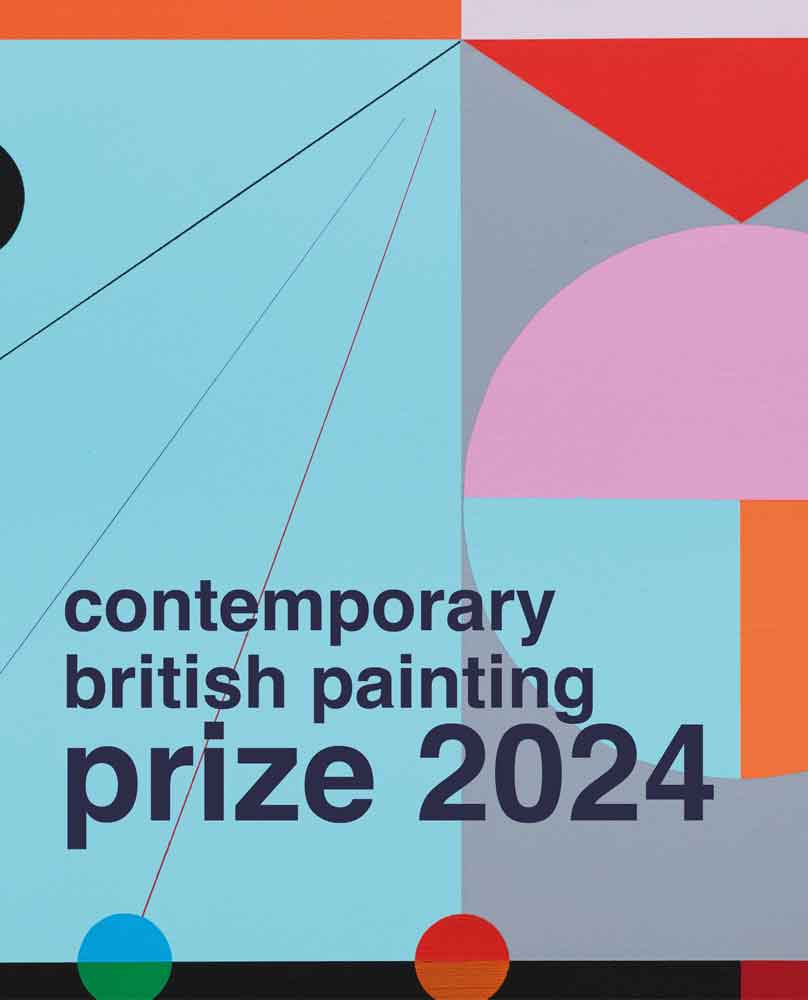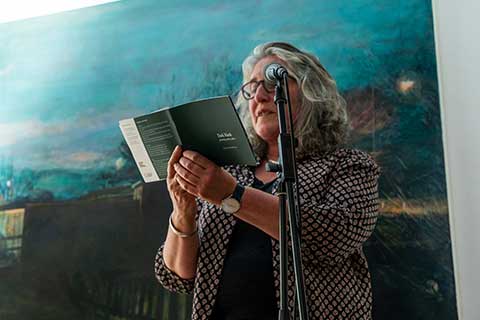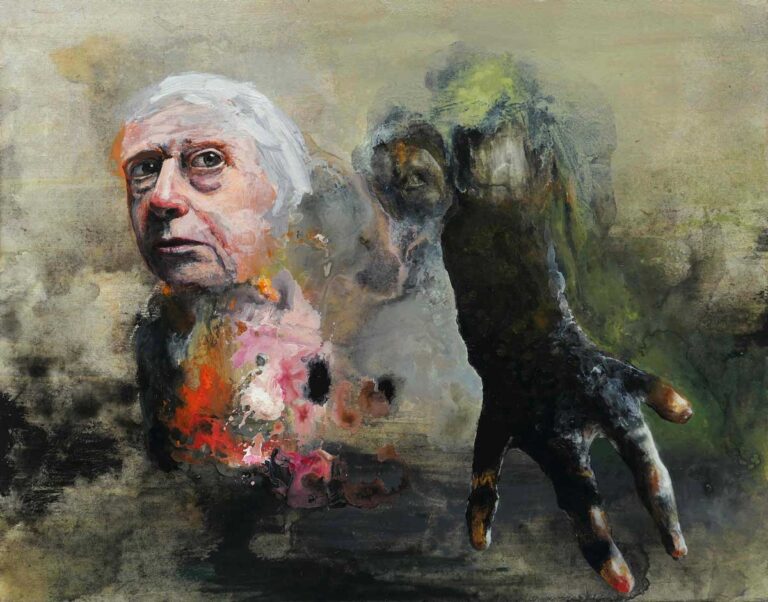A Celebration of Painting
A Celebration of Painting: From a Conversation with Joanna Whittle
An essay by Griselda Pollock
Joanna Whittle was the winner of the 2019 Contemporary British Painting Prize. This essay, by Griselda Pollock (Professor of Social and Critical Histories of Art at the University of Leeds), has been published in the CBP Prize 2019 exhibition catalogue. The essay forms part of the prize.
The winning painter of the Contemporary British Painting competition in 2019 painted the smallest paintings in the exhibition. They were also the most profoundly painterly.
This combination of qualities is already intriguing in an era that has inherited the massive expansion of size effected by the Abstract Expressionists in the mid-twentieth century in order to make us acknowledge painting for itself. It is also fascinating that Joanna Whittle began in that tradition, making large, gestural, layered, abstract paintings about painting. Her works, she tells me, were immersive seeking and creating a sense of ever-expanding or even limitless space.
I then discover that she grew up in desert landscapes in the Middle East. Deserts are remarkable places. They dispossess us of own sense of scale, place, and confound our rationality. It is no surprise that in three inter-relating monotheisms of the world, the invisible deity is encountered ‘behind the desert’. In more banal Western artistic terms, deserts might be considered the defeat of landscape. Deserts are endlessly fascinating and yet without the stabilizing features that engender form and create a scene to delight the roving eye.

Some years ago, I was writing about American painter Georgia O’Keeffe and went to see her former home and studio in Abiquiu. Driving across the vast plains of New Mexico from Albuquerque airport towards Santa Fe, I saw no ‘landscape’, just apparently featureless land stretching flatly to the horizon or dipping unexpectedly into deep ravines carved by the Rio Grande. As the car rolled on, I wondered to myself: how could O’Keeffe have found a way to paint landscape here? Then I arrived at Abiquiu. I looked out of the window of her strategically positioned studio. I saw a view: elements of land, hills, rocks, crags, erosions, and trees that would enable the making of a painting because of a play planes, horizontals and verticals. I was invited to write about O’Keeffe when the Tate Gallery mounted its major show in 2016. I chose the title ‘Seeing Georgia O’Keeffe Seeing’. I tried to trace, for myself, the slow process of her becoming a painter via formal experiments with abstraction and real encounters with the desert. I think a key moment occurred in 1917 when she was living in Texas, a state of vast, flat expanses that have blown the minds of several 20th century painters from Agnes Martin to Walter de Maria. What O’Keeffe discovered there led to her produce a series of watercolours that were neither abstract nor non-abstract, neither landscape nor not-landscape. What she ‘saw’ was where the infinite plains met the immense skies or the sun rimmed the night horizon which only paint freed to be colour, texture, shape could convey. What made these works possible was not description but revelation through a pure economy of colour, water and the sureness of her gesture.

O’Keeffe is not usually classed in the world of painters’ painters. Nor is she considered alongside her apparently abstract New York contemporaries who sought to destroy the ‘view’ by defeating the frame (either abolishing it [Pollock] or taking it inside the painting [Rothko]). I evoke her as part of my journey to seeing what Joanna Whittle is seeing in, and with, painting.
There were precious few women amongst Joanna Whittle’s tutors either on her BA degree in Fine Art at St. Martin’s in the late 1990s or among the artists she was encouraged to study. She nonetheless found the environment at the Royal College, where she completed her MA in 2000, very supportive both artistically and intellectually. Amongst those artists she studied with deep interest at this time were Robert Motherwell, whose gentleness of gesture she valued, and Mark Rothko at the Tate (when on show). Rothko’s close-hued, subdued and moody Seagram Murals (1958) generated both a deeply bodily sensation of being surrounded in an expanded space that had no ground and, at the same time, generated, out of that very groundlessness, a desire to stay there with and within this ungraspable colour-space while giving an elusive form to the melancholy of a profound lostness. Her thesis at the RCA drew upon the concept of Being founded on the abyss – Abgrund – articulated by the German philosopher Heidegger. Each offered a different quality to the young painter asking practically – and theoretically – informed questions about how we find our place in paintings that virtually expand space beyond the positioned, historically mastering gaze before which landscape painting typically exposed the world it formulated to be thus seen. Making works so big that finding a place in their virtual worlds becomes impossible was a 20th century ruse. Immersion is not, however, the same as experiencing space. From reading Maurice Merleau-Ponty, the artist might learn that the experience she was after arises from the phenomenology of being in the world of which you are its flesh. From Gaston Bachelard on the other hand, comes insight about the uncanniness of space and spaces that evoke both our own unseen bodily interiors and our psychically inflected sense of the body, namely the first body we sensed – the maternal body that evokes both unimaginable beginnings within a no-space and our fearful ending – not-being. What if the artist also searches for a way of painting that defies the positioned gaze and the mastering eye precisely because what is being sought in painting is a sensation of spatial being, and an effect that is associated with the painter’s earliest intimations of being in the world, living in space, and sensing that these hold the powerful affects for which painting becomes an always provisional promise and also an ever-exciting threat?

To say that Joanna Whittle lived her childhood in a desert landscape, a desert irregularly interrupted by half-finished, abandoned, or straggling structures at the edges of incipient urban encroachments into the endless sand will illuminate everything and explain nothing. It points to the formation of an imagination and an aesthetic sensibility that will be sensitive to a specific range of effects we meet, the disturbing absences and absentings of the uninhabited (ruins, remains, empty structure). These touch on homelessness or rather unbelonging. They imply radical, alluring and terrifying otherness. They evoke both timelessness and vastness. They may imply a force or presence indifferent to the human and beyond its rationalizing grasp.
The desert and its rich associations serve me as cue to discover the continuities between two moments in Joanna Whittle’s career as a painter. The first moment concerns beginnings. These were played out across undergraduate (St Martins) and graduate (Royal College) fine art study as an abstract painter turned landscape painter to be succeeded by a very well-received professional painting practice with sold-out shows and a distinguished commercial gallery behind her. The second, unnamed moment, emerged after a decisive break from, and then a considered and committed return to, painting with the conviction that what mattered for her life was that she knew herself to be a painter. This word does not describe an activity or a choice of medium so much as but a way of being in the world.
In our conversation in her studio, Joanna Whittle told me about one of those major moments in her life when she stood – for days – before Giovanni Bellini’s painting St Francis in Ecstasy ca.1480 in the Frick Collection, New York. It is also known as St Francis in the Desert. The still abstract artist had, in fact, gone to New York to be immersed in a major retrospective of Jackson Pollock and unexpectedly found herself transfixed by so different a painting practice before the Bellini. There she saw how abstract qualities of painterliness and expanding space co-emerge with a kind of acute attention and rendering of objects. Conjure this painting up before your eyes or check it out on the web, and immediately you might feel what I did when she told me the story. Seeing the image allowed me to understand exactly this lovely deviation from1990s abstraction into the other ‘beginnings’ of painting at the inception of the Italian Renaissance. Then Christian painters, armed with the novel technology of oil paint, were tasked with making real the unreal. This insight could offer a resource for what emerged later in our conversation about how the real is realized by means of both the unreal and the sur-real.

How can Bellini’s painting make its viewers see and witness a moment of transformative spiritual ecstasy? The answer lies in two elements. I suggest the first element is an almost forensic pictorial representation of the world (here trees, rocks, tiny mice and munching donkeys, curling vines and peeping weeds under the canopy of sky with floating clouds and receding into space in graduated planes). The second element is light. To be a world everything must be there, in its finest detail. Yet it can only be realized in this to-be-seen object through technique and materials: drawing and painting, and the knowing and confident manipulation of paint.
I watched a series of talks and films about this recently restored painting where magnification allowed me, remotely, to see into the work of Bellini’s fine haired brush, its load of carefully sculpted paint on the friar’s belt, its layered glazing of hinted at stigmata. What do you do, as an artist trained in post 1950s abstract painting, having then seen Bellini and known that this is what you want to do? Perhaps you call on your contemporaries, who did not live in a world of saints and ecstasy but knew about multiple coexisting realities, material and psychic, and had looked on the horrors of war and death. I am thinking of the painterly Surrealists, Paul Nash perhaps, and in technical terms, of Max Ernst’s decalcomania which technique popped into my mind before Joanna Whittle mentioned his name. She did so, however, to reference some of his effects, but also to differentiate herself from Ernst’s transfer methods. Hers is a layering process, field on field, working colour to prevent its dying back and to bring it forward, to hold its capacity to evoke while asserting its playful autonomy as manipulated substance. It owes something more to a belated recognition of the painterly language of a Suffolk artist, John Constable.
These rather, perhaps inevitably art historical, perambulations, help me build a road to the tiny, immense paintings to which we the judges gave this year’s prize. A prize about contemporary painting has to make us think about painting, that baggy word, made a tad more self-conscious substantive by the modernist turn and the modernist eye it created through which to review all of art’s history. From this opening – all about space, big paintings, landscape and a haunting sense of a world that exceeds our visual grasp and aesthetic formulation – let me return to the opening statement: the fact that her current paintings are small. We should, of course, never confuse size with scale. That is what we discover above all in long and close looking at Joanna Whittle’s current oil paintings on Perspex.
In her recent work, Joanna Whittle has found a ‘motif’. Not a Cézannian mountain in brilliant Provençal sun, her motif is a festival tent at night pitched amidst sodden mud or sailing on muddy floodwater. The tent as object is rich in possibilities.
Unlike the solid rocks of the landscape tradition, or the stony monuments of the Claudian or Turneresque or the rustic brick buildings of Constable, these are fragile, temporary, vernacular and disturbing. An invisible scaffold shapes draped fabric which retains the fluency of classical drapery, the signifier of movement and hence the symbol of emotion and life. As a form, the tent fills a landscape monumentally with a characteristic shape. Its whiteness and gaudy lights challenge the brown-green palette of earth and trees. Yet it has an opening. A cavernous entrance or a blown-open flap reveal impenetrable darkness beyond. This in turns imply a vast, empty, unpeopled void within. Body and/as building, the viewer is tipped into the realm of the uncanny (the term in German is unheimlich, the un-homely). All tents are also instant ruins for they are imply a temporary emplacement. Roaming around festival sites in the hours of silent darkness, the artist makes us encounter day-time sites of noise, crowded entertainment, food drink and music in their silent, secret otherness. Great relics of the culture of the summer festival, they become tomb-like, mournful, rudely colourful or absurdly illuminated by unnatural pink and blue lights, bedraggled pennants. To be a bit inflated, set against trees turned sombre by the night, they perform an encounter between the culture (the festival) and nature (their setting).

Tents and deserts resonate with each other while seeming to be each terms’ opposite. Yet while deserts are imagined, painted and film in wide-format, endless and unbounded, the tent has found its scale in the small paintings. The stately tent is perceived under that strange and uncanny moment of dusk when slowly fading light makes ghostly shapes fade into and loom up in the gloaming. The ten stands guarded by free-form Ernst-like trees emerging out of unseen layers as the painting is slowly realized under the laws of its own dynamic of hot and cold, push and pull, surface and ground, unexpectedly conjoins landscape and figure in a haunting covenant. The tent’s non-natural colours clash with the vegetation and the water in which it is sometimes reflected to assert itself as a surrogate figure. Is it the ghostly shape for a painter’s subjectivity? The temptation to evoke the Surrealists, the Uncanny, and a streak of British Romanticism, while perfectly valid as a way of situating a specific project like Joanna Whittle’s, should be resisted – a little. The freight of the paintings is not a projection of a given mood, a known feeling, an existing condition. Painting is always a discovery and creation of a form through which affects can arise an, in retrospective understanding of the driving impulse, may surface in consciousness. Writing about painting, and these in particular, has been my own wandering journey to recognize what these paintings hold and thus prompt me to explore through language.
The physical smallness of Joanna Whittle’s paintings – where-ever they arrive from and resonate with – make the viewer come physically close, leaving the safe space of the casual stroll past pictures glanced at. They make us really look. Only then, when near and attentive, do we see how intensely painterly they are, how much the effect and the affect arises from the sure confidence of the artist’s touch, the delight of the experienced brush that has animated a tiny inflection on a tree or placed two dots of paint upon each to create a single pink light piercing the damp gloom of the lonely night. Her work is, as the artist said to me a ‘celebration of painting’ in its technical mastery, its knowing relation to its peers and antecedents and ultimately its deeply affective and hence philosophical meditations on being in the world, when human relations to the environment are more acutely significant then ever. This evolution of a landscape painting practice so affectively attuned to the hurt of human alienation and to mourning strikes a deep chord in this moment.
Griselda Pollock, January 2020








